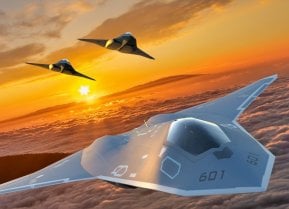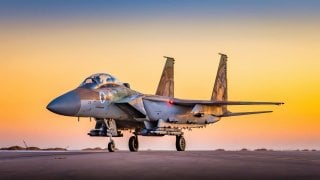The F-15I Ra'am Fighter Is the Heart and Soul of Israel's Air Force
Israel's F-15I Ra'am, a modified variant of the American F-15 Eagle, plays a crucial role in the Israeli Air Force (IAF), especially amidst ongoing conflicts such as the Israeli-Hamas war.
Summary: Israel's F-15I Ra'am, a modified variant of the American F-15 Eagle, plays a crucial role in the Israeli Air Force (IAF), especially amidst ongoing conflicts such as the Israeli-Hamas war. With superior range over the F-35s and F-16s, the Ra'am enhances Israel's defense capabilities, offering advanced avionics, weapons, and long-range strike potential. Originally acquired to counter regional threats post-1991 Gulf War, the F-15I has proven itself in various engagements, including the ability to target deep inside Iranian territory, aligning with Israel's strategic defense needs. Its deployment underscores the IAF's readiness to address threats and secure its borders effectively.
The F-15I Ra'am: Israel's Answer to Regional Threats and Beyond
While Israel’s modified F-35I variant is recognized as the country’s premiere fighter jet, its fleet of F-15I airframes should not be discounted.
In fact, the Israeli Air Force’s “Ra’am” (“Thunder”) fighters have greater range than the service’s F-35s and F-16s. As the Israeli-Hamas war continues to rage on in the aftermath of the October 7 massacre, the IAF’s aerial capabilities remain a top priority for Israel’s security and defense. The F-15I Ra’am fighters undoubtedly play a critical role in these efforts.
Introducing the Eagle
The first American-made F-15 Eagle took its maiden flight nearly four decades ago. When the McDonnell Douglas platform was first introduced, it was meant to replace the U.S. Air Force’s aging F-4 Phantom II fighters.
The Eagle was born out of the U.S. Air Force’s Enhanced Tactical Fighter program, which evolved into the Dual-Role Fighter competition in the early 1980s. Although other airframes were submitted for consideration, the Eagle’s promising design made it the top contender. In addition to the F-15’s lower production costs, engineers believed the platform might be able to incorporate future technologies down the line.
How Did the IAF Acquire the Eagle?
After the 1991 Gulf War, Israeli officials recognized the need for a long-range strike platform capable of identifying and destroying targets threatening its borders. The Jewish state is surrounded by hostile adversaries who wish to see its demise, making this capability a priority for the IAF.
During the Gulf conflict, Iraq had used its arsenal of SCUD ballistic missiles to assault the Jewish state. The Israel Defense Forces’ inability to intercept many of these missiles showed just how lacking the country’s air defense systems were at the time.
The IAF opted to procure 25 air defense platforms in the mid-1990s to fix this shortcoming.
Prior to this, Israel had been flying the F-15 Eagle. These airframes were first deployed in a 1978 operation targeting terror cells in Southern Lebanon, and the Eagle went on to serve as the IAF’s primary fighter against Syria’s Soviet-designed MiG jets during the Lebanon War.
According to IAF Brig. Gen. Moshe Marom-Melnik, every enemy aircraft that attacked its forces in Lebanon was systematically shot down. “We had a field day, basically, shooting down practically everything that flew. The MiG-21 and MiG-23, which formed the backbone of the Syrian air force, were crushed. As far as our squadron was concerned, the war was more like a shooting range.”
Introducing the F-15I Ra’am
In 1994, Israel purchased the F-15I to meet the need it had identified.
The two-seat Eagle variant is equipped with an array of advanced avionics, weapons, communications, and electronic warfare capabilities. Unlike the F-15E Strike Eagle, the Ra’am is a dual-role fighter that combines air superiority and long-range interdiction.
The platform's capabilities include the Hughes APG-70 synthetic aperture radar, the Elbit display and sight helmet system, and the Kaiser holographic head-up display system. The APG-70 provides a sharp picture that enables the fighter’s crew to detect targets regardless of weather conditions.
The Ra’am is also well-equipped. Each F-15I features a single 20mm M61MA1 Vulcan internal automatic cannon and can carry up to 18,000 pounds of fuel and munitions.
Due to its direct link to the Strike Eagle, the Ra’am fighters appear nearly identical. The two crew members sit in tandem, and the twin-engine arrangement is side-by-side. Two vertical planes bookending the twin engine installation are used for ground running, and the wing mainplanes have swept-lines along their leading edges. As detailed by Military Factory, the Ra’am is powered by a pair of Pratt & Whitney F100-PW series afterburning turbofan engines, which can carry the fighter to speeds beyond Mach 2.0.
Operational History
Throughout the F-15I’s years in service, the platform has been frequently deployed in conflicts along Israel’s borders and even abroad, including in Lebanon, Syria, and in Gaza. Perhaps most significantly, the IAF’s Ra’am fleet has the ability to reach deep inside Iranian territory. As part of the Jewish state’s Begin Doctrine, the IDF needs to maintain the capability to terminate Tehran’s ability to develop and produce weapons of mass destruction.
About the Author: Maya Carlin
Maya Carlin, National Security Writer with The National Interest, is an analyst with the Center for Security Policy and a former Anna Sobol Levy Fellow at IDC Herzliya in Israel. She has by-lines in many publications, including The National Interest, Jerusalem Post, and Times of Israel. You can follow her on Twitter: @MayaCarlin. Email the author: [email protected].
Image Credit: IDF.


